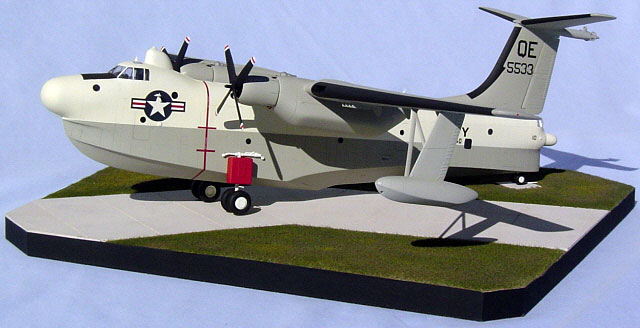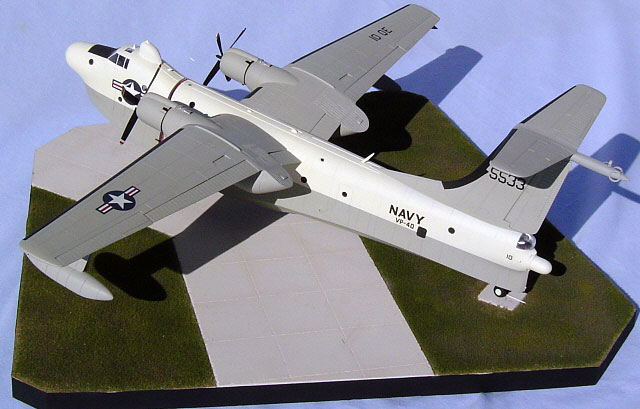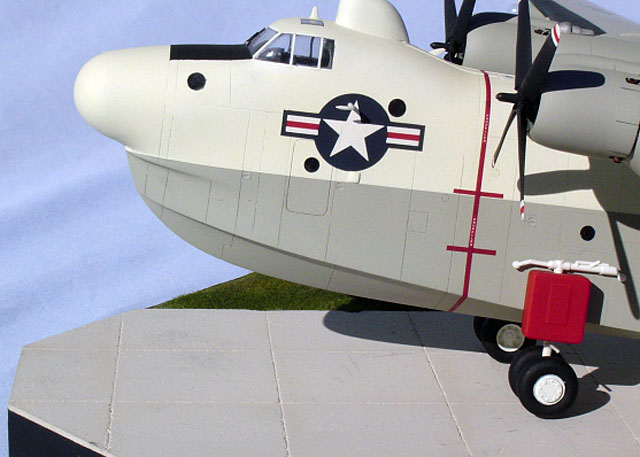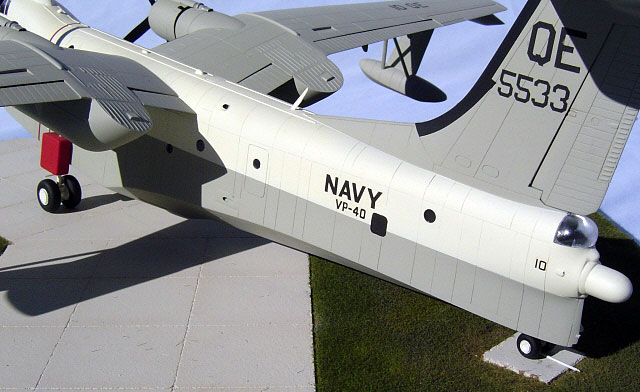Hasegawa's 1/72 scale
Martin SP-5B Marlin
by Michael Rieth

|
Martin SP-5B Marlin |

HyperScale is proudly supported by Squadron.com
This photo essay should be subtitled "A Cursed Perfectionist’s Battle With Murphy's Law".
This model almost hit the wall three times out of frustration, as I made several goofs. The first time was when, after scribing all the panel lines and sanding and polishing the cockpit clear part flush with the rest of the hull/fuselage, replaced all the “portholes” and windows, I wet sanded the entire model. A drop of sanding "slurry" deposited itself right in the middle of the windshield, on the inside, preventing me from cleaning it off. Doh! I had to pop off the cockpit glass, re-glue and start over.

Next impulse to launch the model into the wall was when I sprayed the model with Testors Model Master Gloss White and it would not cover the scribed panel lines. The more coats I put on, the more the paint refused to go in the lines, which caused the paint to build up like levees or dikes on both sides of the panel lines. Throw it now, no.
I decided that the paint hadn’t cured yet, so I could remove it with Mineral Spirits or enamel paint thinner. I mistakenly grabbed Testors Airbrush Thinner, a “hotter”, more powerful thinner and applied liberally with a brush. The paint came off easily, but it made the plastic brittle and as I carefully cleaned the paint out of the panel lines with a soft toothbrush, the edges of the panel line became less distinct and irregular. I did not throw the model against the wall this time either; I just took a deep breath and put the model aside for awhile. I came back later, much later, months later and decided that I had put too much time and effort into scribing the model to throw it away. I just had to finish this model. I ran my scriber along the lines again. I cleaned up the panel lines with an ultra fine 3M Scotchbrite pad. It should look good under a coat of paint I thought, so I continued.
Hasagawa’s Marlin is 1970’s technology, but it still goes together nicely. It has raised panel lines and rivets. The parts fit together with no big gaps to fill. It makes a nice model out of the box.
I decided to improve the model.
I scribed all the panel lines with a drafting needle in a pin vise and on this model kit, there were a lot of lines.
The cockpit was detailed with a new scratch-built instrument panel, control columns, overhead throttle quadrant and arm rests and seat belts, which can't be seen very well once closed up.
I replaced the “portholes” or windows with clear acrylic rod, which I turned on my Sherline lathe. I also replaced the “waist” windows with thin clear acrylic sheet. The cockpit clear part was glued on and all windows were sanded flush to the surface and polished with the Micro-mesh sanding kit.

The two raised “rails” along the spine of the hull/fuselage were sanded off, so I could scribe around the top and replaced them with styrene strips.
The MAD boom was detailed with rings that I made using a drafting compass with 2 drafting needles to cut the .010“ styrene sheet and a short piece of styrene tube was glued on top.
The beaching gear was detailed. A tow bar was made for the tail wheel.
Tie down holes on the wing floats were opened up.
The wing intakes were corrected.
Using reference photos, holes were drilled in the hull/fuselage and plastic tubes glued on the inside for the ejector ports for the sonar buoys, flares, etc.
 The entire model was glued together before painting. The entire model was glued together before painting.
The wing was glued to the hull/fuselage and the joint filled and sanded. The model was finished with Testor's Model Master Flat White and Flat Light Gull Gray. The gray was sprayed first, because it was easier to mask for the white, than the gray.
The demarcation line on the hull/fuselage was masked with 3M 1/8th inch blue tape. I started at the rear of the model and worked forward. I worked slowly and had to lift the tape and start over many times to get a straight line. The deicer boots were masked and painted flat black.
Decals were applied.
Final finish coat was Testors Flat Clear Lacquer.

Decals came from the spares box. The numbers and letters were modified from a decal sheet of black numbers and letters. The clear areas were cut from all of the decals, except the small #10 and the VP-40, which came from the kit. It is important to remove the clear decal area on a white colored model, because as the years go by, the decals will yellow, even on a model covered in clear coat.
Base
The base is sawdust/resin particle board. The grass area was routed to a lower level. The concrete joint lines were scribed. Static grass was glued on and painted. The base represents the area where the Marlin was on display in the late 1980's at the National Museum of Naval Aviation in Pensacola, Florida.
This model was a testament to perseverance, but it was worth it. The model has taken several awards in model contest, including The Best U.S. Navy Seaplane Award at the 1999 IPMS/USA Nationals in Orlando, Fla. and 1st Place at the National Museum of Naval Aviation in Pensacola, Florida.
If you have a model that is “fighting” you, don’t give up, put it aside and come back to it later. Who knows what gem is awaiting completion.
The Martin P5M Patrol Seaplane by Capt. Richard Hoffman USN (Ret), Naval Fighters Number Seventy-Four
The Martin P5M Marlin: The End of an Era in Naval Seaplane Aviation by Bruce D. Barth
The Official Monogram US Navy & Marine Corps Aircraft Color Guide Vol. 3 1950-1959 by John M. Elliot Maj. USMC (Ret)
Navy Air Colors United States Navy, Marine Corps, and Coast Guard Aircraft Camouflage and Markings Vol. 2 1945-1985 by Thomas E. Doll, Berkley R. Jackson and William A. Riley.
http://www.vpnavy.com/
Model, Images and
Text Copyright © 2008 by Michael Rieth
Page Created 25 February, 2008
Last Updated 25 February, 2008
Back to HyperScale
Main Page |
Home
| What's New |
Features |
Gallery |
Reviews |
Reference |
Forum |
Search